Seismogenic-Triggering Mechanism of Gas Emission Activizations on the Arctic Shelf and Associated Phases of Abrupt Warming
Abstract
1. Introduction
2. Evidence for the Seismogenic Origin of Climate Changes in the Arctic
2.1. Great Earthquakes in the World and Within the Aleutian Arc
2.2. Slow Tectonic Diffusion as Possible Stress Disturbance Transmission Mechanism
2.3. Methane Release Due to Stress Propagation
3. Conclusions
Funding
Acknowledgments
Conflicts of Interest
References
- Kvenvolden, K.A. Methane hydrates and global climate. Glob. Biogeochem. Cycles 1988, 2, 221–229. [Google Scholar] [CrossRef]
- Koven, C.D.; Ringeval, B.; Friedlingstein, P.; Ciais, P.; Cadul, P.; Khvorostyanov, D.; Krinner, G.; Tamocai, C. Permafrost carbon-climate feedback accelerated global warming. Proc. Natl. Acad. Sci. USA 2011, 108, 14769–147774. [Google Scholar] [CrossRef]
- Shakhova, N.; Semiletov, I.; Sergienko, V.; Lobkovsky, L.; Yusupov, V.; Salyuk, A.; Salomatin, A.; Chernykh, D.; Kosmach, D.; Panteleev, G.; et al. The East Siberian Arctic Shelf: Towards further assessment of permafrost-related methane flux and role of sea ice. Phil. Trans. R. Soc. A 2015, 373, 20140451. [Google Scholar] [CrossRef]
- Shakhova, N.; Semiletov, I.; Gustafsson, O.; Sergienko, V.; Lobkovsky, L.; Dudarev, O.; Tumskoy, V.; Grigoriev, M.; Mazurov, A.; Salyuk, K.; et al. Current rates and mechanisms of subsea permafrost degradation in the East Siberian Arctic Shelf. Nat. Comm. 2017, 8, 15872. [Google Scholar] [CrossRef]
- Obzhirov, A.I.; Emelyanova, T.A.; Telegin, Y.A.; Shakirov, R.B. Gas flows in the Sea of Okhotsk resulting from Cretaceous-Cenozoic tectonomagmatic activity. Rus. J. Pac. Geol. 2020, 14, 156–168. [Google Scholar] [CrossRef]
- Kasatkin, S.A.; Obzhirov, A.I. Fluid-controlling significance of the Nosappu fracture zone and conditions for the formation of methane fluxes and gas hydrates (Sea of Okhotsk region). Rus. J. Pac. Geol. 2018, 12, 57–62. [Google Scholar] [CrossRef]
- Shakirov, R.B.; Obzhirov, A.I.; Salomatin, A.S.; Makarov, M.M. New data on lineament control of modern centers of methane degassing in east Asian seas. Dokl. Earth Sci. 2017, 477, 1287–1290. [Google Scholar] [CrossRef]
- Ershov, V.V.; Shakirov, R.B.; Obzhirov, A.I. Isotopic-geochemical characteristics of free gases of the South Sakhalin mud volcano and their relationship to regional seismicity. Dokl. Earth Sci. 2011, 440, 1334–1339. [Google Scholar] [CrossRef]
- Obzhirov, A.; Shakirov, R.; Salyuk, A.; Biebow, N.; Salomatin, A. Relations between methane venting, geological structure and seismo-tectonics in the Okhotsk Sea. Geo-Mar. Lett. 2004, 24, 135–139. [Google Scholar] [CrossRef]
- The Arctic: Seismic Activity May Cause Arctic Climate Change. Available online: https://arctic.ru/climate/20200310/931975.html (accessed on 13 July 2020).
- Laverov, N.P.; Lobkovsky, L.I.; Kononov, M.V.; Dobretsov, N.L.; Vernikovsky, V.A.; Sokolov, S.D.; Shipilov, E.V. A Geodynamic Model of the Evolution of the Arctic Basin and Adjacent Territories in the Mesozoic and Cenozoic and the Outer Limit of the Russian Continental Shelf. Geotectonics 2013, 47, 1–30. [Google Scholar] [CrossRef]
- Lobkovsky, L.I.; Kononov, M.V.; Shipilov, E.V. Geodynamic model of upper mantle convection and transformations of the Arctic lithosphere in the Mesozoic and Cenozoic. Izvestiya. Phys. Solid Earth 2013, 49, 767–785. [Google Scholar] [CrossRef]
- Lobkovsky, L.I.; Baranov, B.V.; Ivaschenko, A.I.; Dozorova, K.A. Earthquakes, underwater landslides and tsunamis. In World Ocean; Lobkovsky, L.I., Ed.; Nauchny Mir: Moscow, Russia, 2013; Volume 1, pp. 363–402. (In Russian) [Google Scholar]
- Elsasser, W.V. Convection and stress propagation in the upper mantle. In The Application of Modern Physics to the Earth and Planetary Interiors; Runcorn, S.K., Ed.; John Wiley: New York, NY, USA, 1969; pp. 223–246. [Google Scholar]
- Melosh, H.J. Nonlinear stress propagation in the Earth’s upper mantle. J. Geophys. Res. 1976, 81, 5621–5632. [Google Scholar] [CrossRef]
- Garagash, I.A. Phase transitions as possible source of the oscillating motion of the lithosphere. Dokl. Akad. Nauk USSR 1984, 297, 1069–1073. (In Russian) [Google Scholar]
- Yakushev, V.S. Natural Gas and Gas Hydrates in Permafrost; VNIIGAZ: Moscow, Russia, 2009; p. 192. (In Russian) [Google Scholar]
- Handa, Y.P. Calorimetric determination of the composition, enthalpies of dissociation and heat capacities in the rang 85 to 270 K for clathrate hydrates of xenon and krypton. J. Chem. Thermodynamics 1986, 18, 891–902. [Google Scholar] [CrossRef]
- Davidson, D.W.; Garg, S.K.; Gough, S.R.; Handa, Y.P.; Ratcliffe, C.I.; Ripmeester, J.A.; Tse, J.S.; Lawson, W.F. Laboratory analyses of a naturally occurring gas hydrate from sediment of the Gulf of Mexico. Geochimetric et Cosmochimica Acta 1986, 50, 619–623. [Google Scholar] [CrossRef]
- Handa, Y.P. Calorimetric study of naturally occurring gas hydrates. Ind. Eng. Chem. Res. 1988, 27, 872–874. [Google Scholar] [CrossRef]
- Ershov, E.D.; Yakushev, V.S. Experimental treatment research on gas hydrate decomposition in frozen rocks. Cold Reg. Sci. Technol. 1992, 20, 147–156. [Google Scholar] [CrossRef]
- Istomin, V.A.; Yakushev, V.S. Gas-Hydrate self-Preservation effect//Physics and Chemistry of Ice; Hokkaido University Press: Sapporo, Japan, 1992; pp. 136–140. [Google Scholar]
- Ershov, E.D.; Lebedenko, Y.P.; Chuvilin, E.M.; Yakushev, V.S. Experimental studies of the ice-methane hydrate agglomerate microstructure. Eng. Geol. 1990, 3, 38–44. (In Russian) [Google Scholar]
- Arzhanov, M.M.; Malakhova, V.D.; Mokhov, I.I. Conditions of formation and dissociation of methane hydrate during last 130 000 years based on model calculations. Dokl. Earth Sci. 2018, 481, 89–94. [Google Scholar]
- Sitnov, S.A.; Mokhov, I.I. Anomalies of methane content in atmosphere over North Eurasia in summer 2016. Dokl. Earth Sci. 2018, 480, 223–228. [Google Scholar] [CrossRef]
- Mokhov, I.I.; Smirnov, D.A. Estimation of contribution of Atlantic multi decade oscillations and changes of atmosphere content of greenhouse gases to trends of near surface temperature based on observational data. Dokl. Earth Sci. 2018, 480, 97–102. [Google Scholar] [CrossRef]
- Denisov, S.N.; Yeliseev, A.V.; Mokhov, I.I. Contribution of nature and anthropogenic emissions of CO2 and CH4 from Russian territory to global climate change in XXI century. Dokl. Earth Sci. 2019, 488, 74–80. [Google Scholar] [CrossRef]
- Muryshev, K.E.; Yeliseev, A.V.; Denisov, S.N.; Mokhov, I.I.; Arzhanov, M.M.; Timazhev, A.V. Phase shift between changes of global temperature and CO2 content in atmosphere under external emissions of greenhouse gases to atmosphere. Izvestiya of RAS Phys. Atm. Ocean. 2019, 55, 11–19. [Google Scholar]
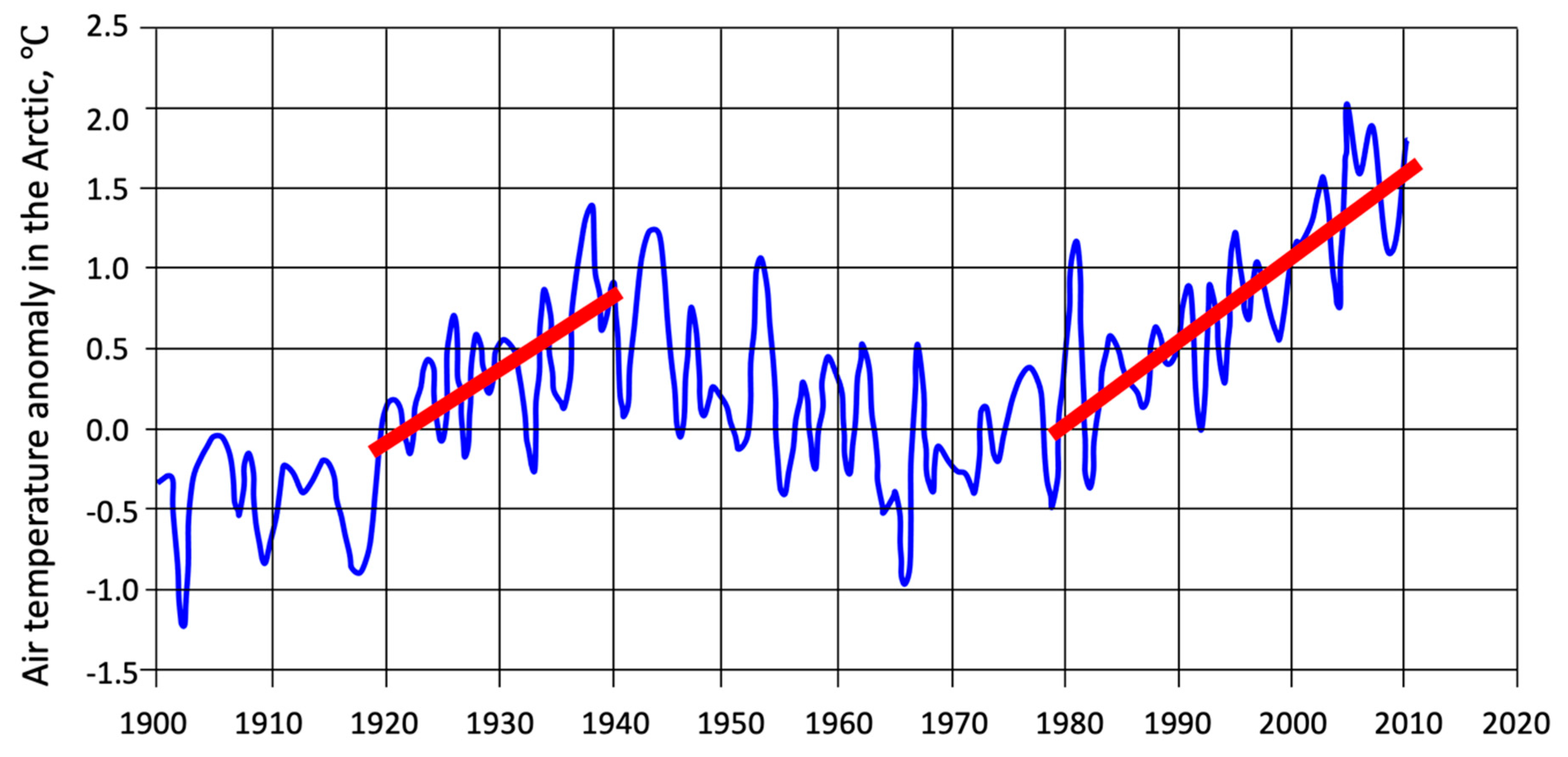
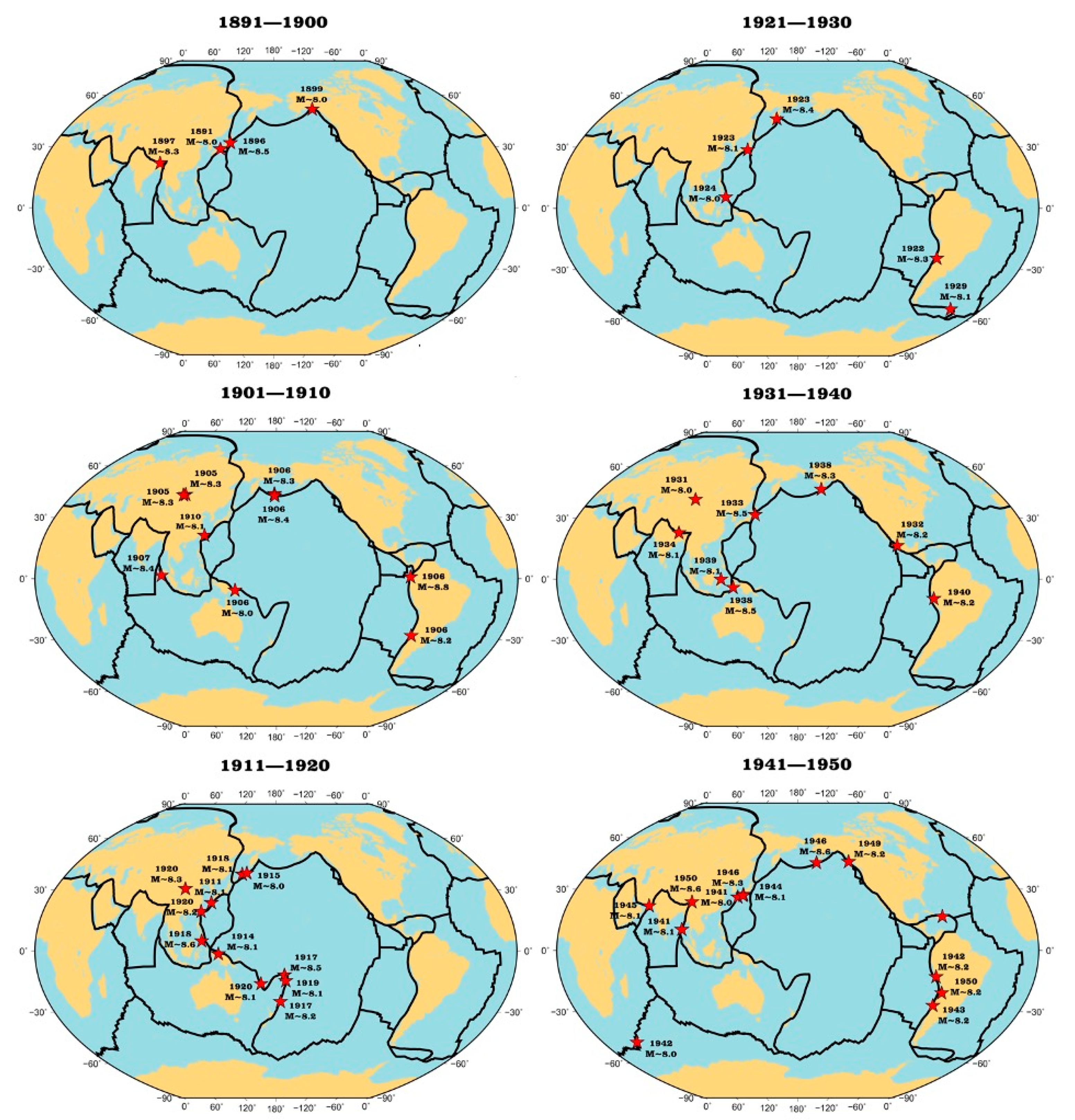
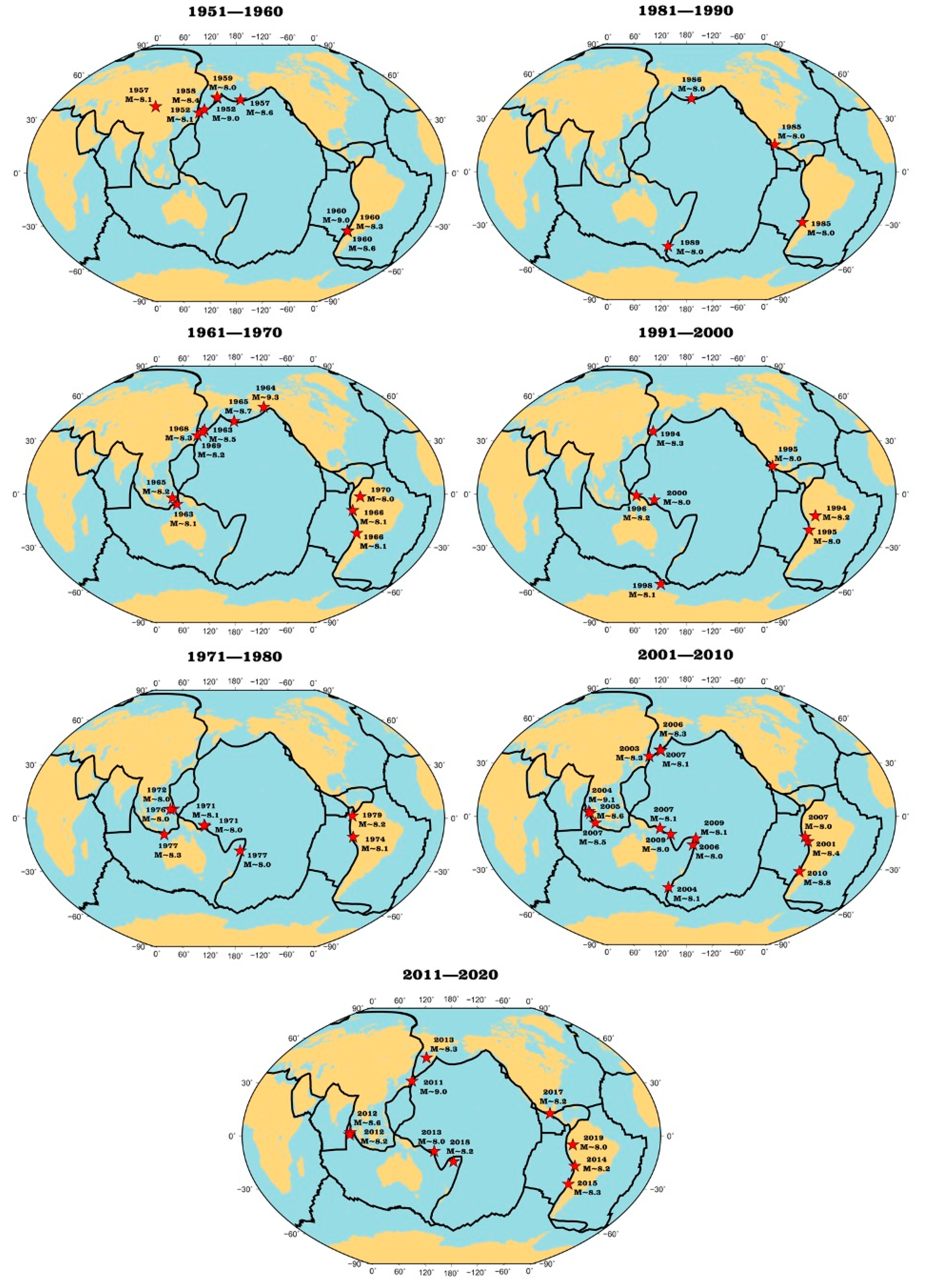
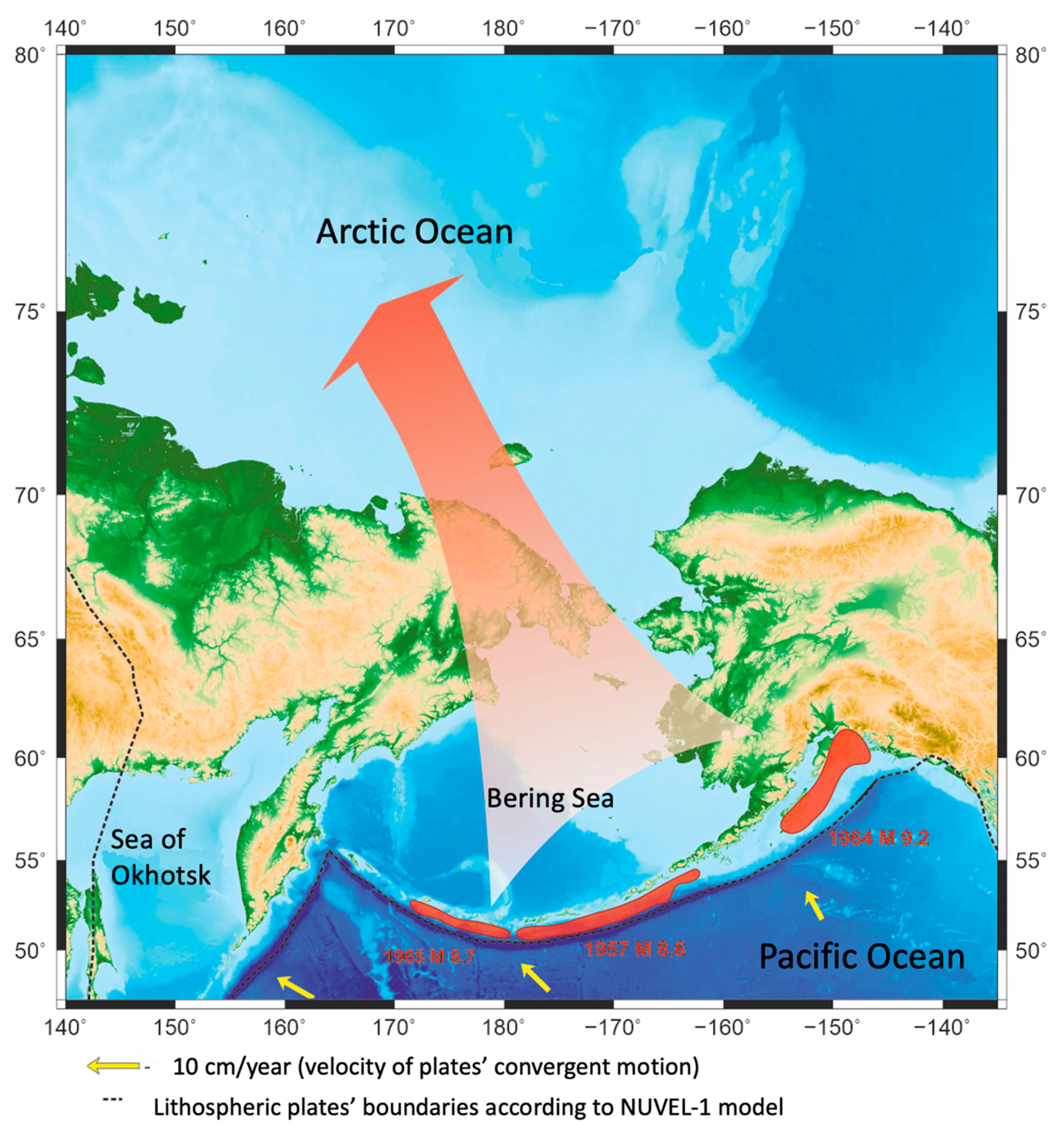
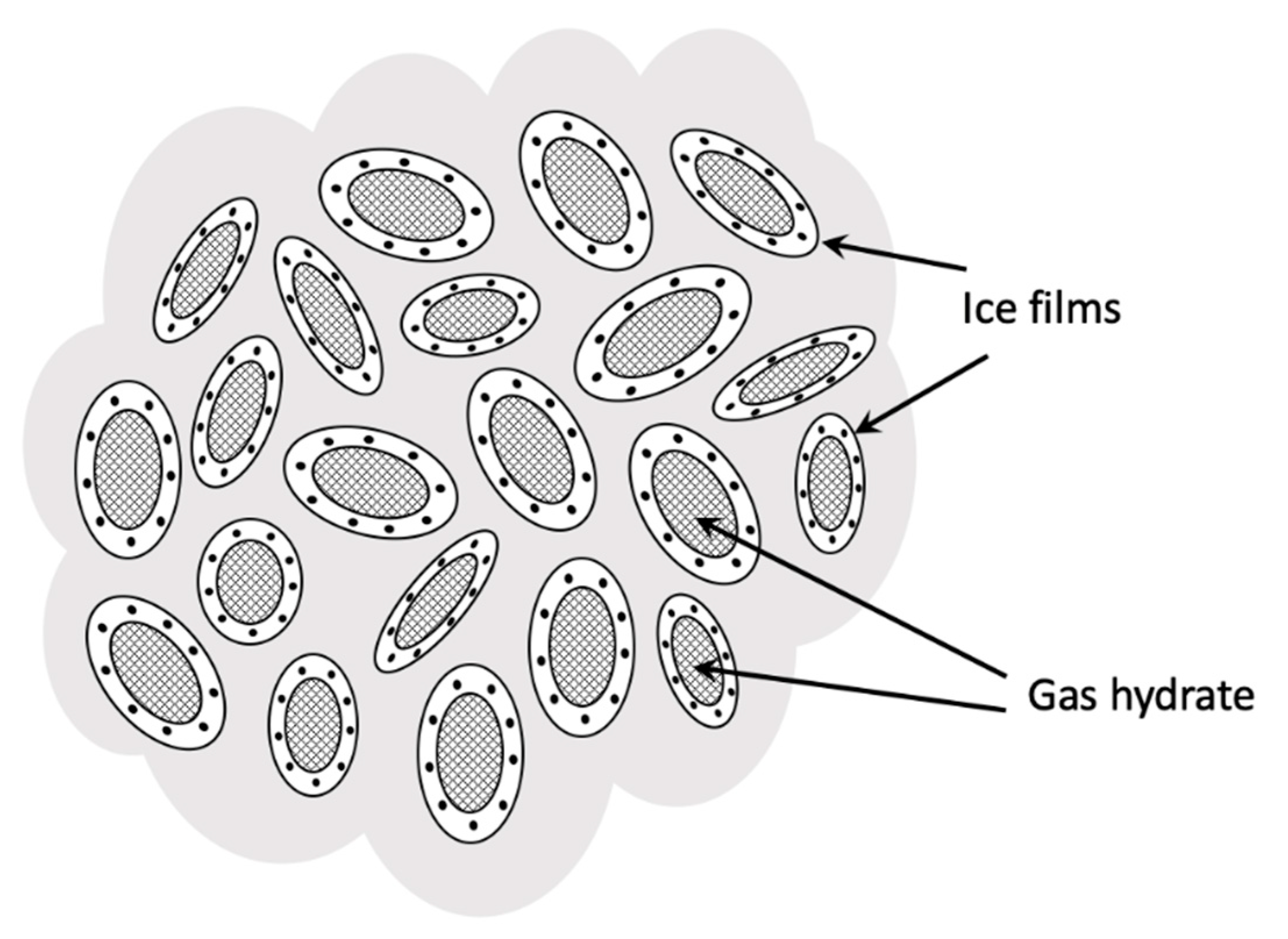
Publisher’s Note: MDPI stays neutral with regard to jurisdictional claims in published maps and institutional affiliations. |
© 2020 by the author. Licensee MDPI, Basel, Switzerland. This article is an open access article distributed under the terms and conditions of the Creative Commons Attribution (CC BY) license (http://creativecommons.org/licenses/by/4.0/).
Share and Cite
Lobkovsky, L. Seismogenic-Triggering Mechanism of Gas Emission Activizations on the Arctic Shelf and Associated Phases of Abrupt Warming. Geosciences 2020, 10, 428. https://doi.org/10.3390/geosciences10110428
Lobkovsky L. Seismogenic-Triggering Mechanism of Gas Emission Activizations on the Arctic Shelf and Associated Phases of Abrupt Warming. Geosciences. 2020; 10(11):428. https://doi.org/10.3390/geosciences10110428
Chicago/Turabian StyleLobkovsky, Leopold. 2020. "Seismogenic-Triggering Mechanism of Gas Emission Activizations on the Arctic Shelf and Associated Phases of Abrupt Warming" Geosciences 10, no. 11: 428. https://doi.org/10.3390/geosciences10110428
APA StyleLobkovsky, L. (2020). Seismogenic-Triggering Mechanism of Gas Emission Activizations on the Arctic Shelf and Associated Phases of Abrupt Warming. Geosciences, 10(11), 428. https://doi.org/10.3390/geosciences10110428



